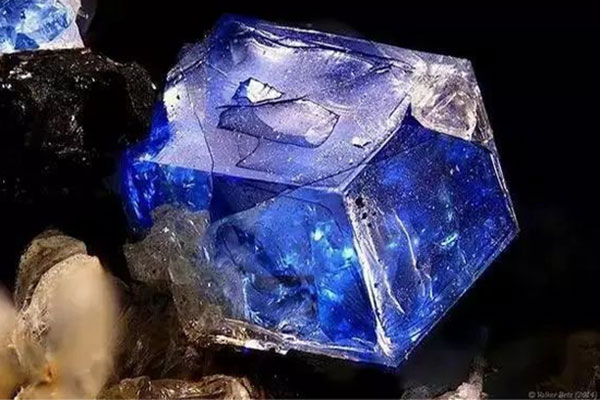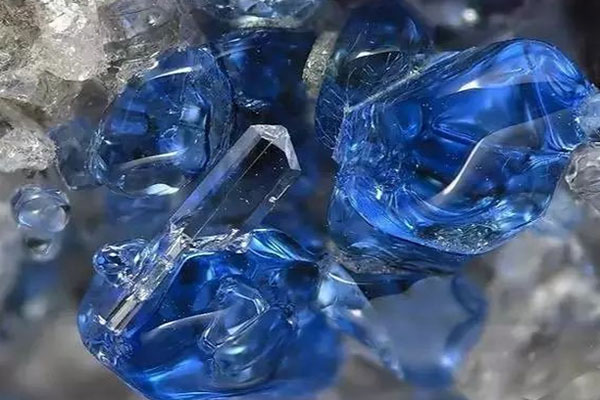Hauyne is named after the famous crystallizer Hauy. The Chinese name “蓝方石” describes that the mineral is blue.
The blue part of lapis lazuli is often composed of Hauyne, Lazulite, and sodalite.
In terms of arts and crafts, The crystal is required to be blue, transparent, and with large particle size; The dense blocks are bright blue or other bright colors.
Faceted gemstones weighing 1-2 carats have sold on the market but are rare; There are many cambered gems of different sizes. Large blocks can be used as jade carving materials.
- Chemical composition: Na6Ca2 [AISiO4] 6 (SO4), often containing impurities such as potassium and chlorine.
- Crystal system: Hauyne belongs to the equiaxed crystal system
- Morphology: The crystal is a rhombic dodecahedron or octahedron, and single crystal is rare, often in the form of round granular aggregate.
- Double crystals are formed according to (111). Space group P43m. Ao=9.13A。 Z=1. Spectral lines of main powder crystals: 6.45 (30), 3.721 (100), 2.883 (30), 2.631 (50), 2.149 (30), 1.788 (30), 1.612 (30).
- Hardness: 5.5~6.
- Relative density: 2.44 ~ 2.50.
- Refractive index: 1.496~1.50.
- Cleavage: 110 medium cleavage.
- Transparency: transparent, translucent to opaque.
- Gloss: glass luster to grease luster.
- Color: blue or blue-green; Hauyne is the component mineral of lapis lazuli and is also the main coloring mineral of lapis lazuli blue.
- Fluorescence: orange-red under long-wave ultraviolet light.
- Cutting: sapphire crystals are occasionally polished into faceted or cambered gemstones for collection.
- Origin: mainly produced in Germany, Italy, and Morocco.

Physical Properties of Hauyne
Hauyne is dark blue, sky blue or greenish blue, white, and gray; a few are yellow or red, with and glass luster.
The fracture surface is greasy luster. it is translucent to transparent, and homogeneous. The refractive index is 1.496~1.505. With {110} medium cleavage, the hardness is 5.5~6.0, and the density is 2.4~2.5g/cm.
Hauyne is colorless or light blue in thin slices. It is easy to be dissolved into jelly by acid. If dissolved in nitric acid, needle-shaped gypsum crystals can appear after slow evaporation, distinguishing from similar sodalite and calcite.
The crystals are rhombic dodecahedrons and octahedrons, but more often are round-grained, granular, or massive aggregates. It has clear rhombic dodecahedral cleavage, and twin crystals (111).
The crystal contains magnetite, ilmenite, hematite, limonite, pyrite, aegirine augite, and other inclusions, which are often distributed symmetrically.
Optical properties of Hauyne
The phenocrysts are usually euhedral, with a hexagonal cross-section. The flakes are sometimes colorless but usually have varying degrees of blue.
There is a clear cleavage. The negative protrusions are more obvious. Like ashlar, there are many symmetrically distributed inclusions in it, which darken the crystal color. It is generally completely black under the orthogonal polarizers, showing uniform but also dark gray interference color, and the birefringence can reach 0.004.
It can emit orange-red fluorescence under ultraviolet long-wave irradiation. It is obviously blue under the transmission light, sometimes colorless.
Where is Hauyne from
It mainly occurs in alkaline volcanic rocks and contact metamorphic rocks. It is one of the main components in the Hauyne Phonolite, Hauyne eclogite leucite, Hauyne carbonatite lamprophyre and Scheumann. Symbiosis with garnet, leucite, etc. It is mainly produced in the palaeovolcanic rock of Germany and Morocco.

How to identify Hauyne
It can be distinguished from other minerals according to its blue, negative protrusion, cleavage, and other characteristics.
The difference from sodalite is that the color of Hauyne is darker. However, it is better to use microscopic chemical reactions to distinguish them for light Hauyne.
Sodalite, calcite, Hauyne, etc., belong to the sodalite family.
Simple chemical tests can distinguish sodalite group minerals.
Step:
Place minerals on glass slides and add a little nitric acid. Sodium cristobalite can precipitate halite crystals after the nitric acid evaporates slowly;
Acicular gypsum crystals were precipitated from Hauyne; There is no crystal in the noselite, and only adding a little calcium chloride can precipitate halite and gypsum crystals.
Hauyne is similar to gemstones.
The varieties of gemstones similar to Hauyne mainly include lapis lazuli, sodalite, sapphire, tanzanite, Paraiba tourmaline, “Paraiba” apatite, cobalt blue spinel, blue glass, etc.
Among them, the gemological parameters of lapis lazuli and sodalite are close to those of Hauyne, but most of them appear in the form of aggregates, and single crystals are rare;
However, other gemstones and Hauyne are relatively easy to identify by their optical property, refractive index, hardness, relative density, absorption spectrum, ultraviolet fluorescence characteristics, etc.
Conclusion:
Hauyne is blue or blue-green, which is a component mineral of lapis lazuli and is also the main coloring mineral of lapis lazuli blue.
The crystal of Hauyne is very small, resulting in smaller gemstones produced. They can be polished into faceted or cambered gemstones for collection.
Hauyne is mainly produced in alkaline volcanic rocks and coexists with leucite, garnet, melilite, olivine, biotite, apatite, phlogopite, etc.
The countries that produce gem-grade Hauyne include Canada, the United States, France, Germany, Italy, Morocco, etc.
